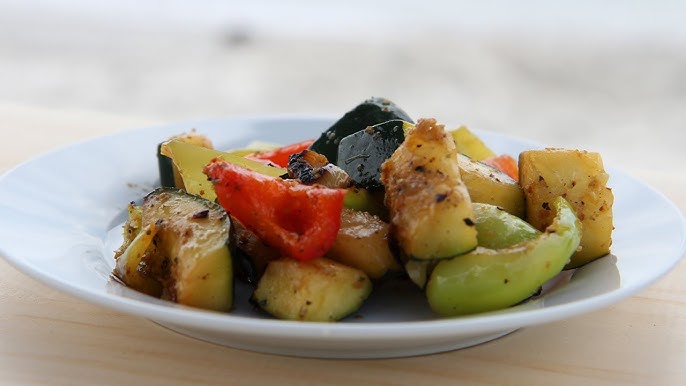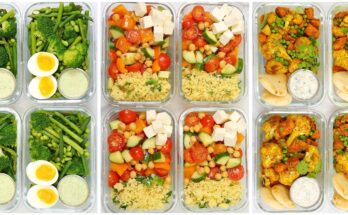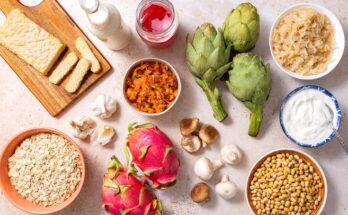Grilled Veggies Recipe: There’s something magical about grilled vegetables. The smoky flavor, the charred edges, and the burst of natural sweetness make them an irresistible addition to any meal. Whether you’re hosting a summer barbecue, preparing a light dinner, or simply looking for a healthy snack, grilled veggies are the way to go. Not only are they quick and easy to make, but they also pack a punch of nutrients that your body will thank you for.
In this guide, we’ll cover everything you need to know about grilling vegetables—from the ingredients and tools you need, to a step-by-step cooking process that guarantees perfect results every single time. So, grab your tongs and apron, because by the end of this article, you’ll be ready to grill like a pro!
Introduction to Grilled Vegetables
Grilled vegetables are more than just a side dish; they’re a flavor-packed experience. Imagine biting into a juicy zucchini slice with grill marks that taste smoky and slightly sweet, or enjoying caramelized onions that melt in your mouth. That’s the beauty of grilling—transforming simple veggies into restaurant-quality delights at home.
Why Grilled Veggies Are the Perfect Side Dish
Grilled vegetables are incredibly versatile. You can pair them with grilled chicken, steak, or fish, toss them into salads, or even use them as a filling for wraps and sandwiches. They complement almost every main course without overpowering the dish. Plus, they’re a crowd-pleaser at gatherings since even non-vegetarians love their smoky flavor.
Another reason they’re perfect is convenience. Unlike complicated side dishes that take hours to prepare, grilled veggies are quick, easy, and customizable. Have leftover bell peppers or mushrooms sitting in the fridge? Toss them on the grill, and you’ve got a vibrant, colorful dish in minutes.
Health Benefits of Grilled Vegetables
Eating grilled vegetables isn’t just about taste—it’s about health too. Since grilling requires minimal oil, it helps cut down on unnecessary fats. Vegetables retain most of their vitamins and minerals when cooked this way, especially when compared to boiling. Antioxidants like vitamin C, beta-carotene, and polyphenols remain intact, boosting your immune system and protecting against diseases.
Also, grilled veggies can help with weight management. They’re high in fiber, keeping you full for longer while being low in calories. Add to that the fact that they’re rich in hydration (since most vegetables have high water content), and you’ve got a dish that’s not only tasty but also nourishing.
Ingredients You’ll Need
Every great recipe starts with the right ingredients, and grilled vegetables are no different. While you can experiment with what’s in your kitchen, some vegetables naturally shine when grilled.
Fresh Vegetables to Choose From
Here’s a list of veggies that are perfect for grilling:
- Zucchini and yellow squash
- Bell peppers (red, green, yellow, orange)
- Mushrooms (button, cremini, portobello)
- Onions (red, white, or yellow)
- Corn on the cob
- Asparagus
- Eggplant
- Carrots
- Cherry tomatoes
- Broccoli or cauliflower florets
Pro tip: Always pick fresh, firm vegetables. The fresher they are, the more vibrant the flavor after grilling.
Oils, Herbs, and Seasonings
Seasoning makes a big difference. A drizzle of olive oil not only prevents veggies from sticking to the grill but also helps lock in moisture. Here’s what you’ll need:
- Olive oil or avocado oil
- Salt (sea salt or Himalayan salt for added minerals)
- Black pepper
- Garlic powder or minced garlic
- Paprika or chili flakes (for a little kick)
- Fresh herbs like rosemary, thyme, basil, or parsley
- Lemon juice for freshness
Optional Add-ons for Extra Flavor
Want to elevate your grilled veggies? Try these optional add-ons:
- Balsamic glaze for a sweet-tangy flavor
- Parmesan cheese for a savory finish
- Soy sauce or teriyaki sauce for an Asian twist
- Crumbled feta cheese for a Mediterranean flair
- Toasted nuts or seeds for crunch
With these ingredients, your grilled veggies will never be boring!
Essential Tools and Equipment
While you don’t need fancy gadgets, the right tools can make grilling veggies easier and more enjoyable.
Best Grills for Perfect Results
You can use any type of grill, but each one gives slightly different results:
- Gas grill – Quick to heat up and easy to control. Perfect for weeknight dinners.
- Charcoal grill – Adds a smoky, authentic flavor. Great for BBQ parties.
- Electric grill – Convenient for indoor cooking, especially if you live in an apartment.
- Grill pan – A stovetop option when you don’t have access to an outdoor grill.
Useful Accessories for Easy Grilling
- Tongs – For flipping veggies without piercing them.
- Grill basket – Keeps smaller vegetables like cherry tomatoes from falling through the grates.
- Skewers – Perfect for making veggie kebabs.
- Basting brush – For applying marinades evenly.
- Aluminum foil – Useful for wrapping delicate veggies or creating foil packets.
Having these tools handy will make your grilling session smooth and stress-free.
Preparing Vegetables for Grilling
Preparation is the secret to perfectly grilled vegetables. If you skip this step, you risk uneven cooking or bland flavors.
Washing and Cutting Techniques
Always start by thoroughly washing your vegetables. Dirt and pesticides can ruin the taste and texture. After washing, dry them with a clean towel to avoid excess water, which can cause steaming instead of grilling.
Cutting matters too. Keep the pieces uniform in size so they cook evenly. For example, slice zucchini lengthwise into strips about half an inch thick. Bell peppers should be cut into wide strips, while mushrooms can be grilled whole or halved depending on their size.
Marination Tips for Maximum Flavor
Marinating your veggies can take them to the next level. A simple olive oil, garlic, salt, and pepper mix works wonders. For more flavor, try balsamic vinegar, lemon juice, or soy sauce-based marinades. Let the vegetables sit in the marinade for at least 15–30 minutes before grilling.
If you’re short on time, just toss the veggies in oil and spices right before grilling. But trust me—those extra minutes of marination make all the difference in taste!
Step-by-Step Guide to Grilling Vegetables
Now comes the fun part—grilling! Follow these steps to get perfectly charred, flavorful veggies every single time.
Step 1 – Preheating the Grill
Preheat your grill to medium-high heat (around 375°F–400°F). A hot grill ensures that veggies sear quickly, locking in flavor while keeping them juicy inside.
Step 2 – Preparing the Veggies
Take your marinated vegetables and arrange them on a tray. Make sure they’re coated evenly with oil and seasoning. Don’t overcrowd them, as this can cause uneven cooking.
Step 3 – Seasoning and Oiling
Before placing veggies on the grill, give them a final brush of oil to prevent sticking. You can also sprinkle fresh herbs at this stage for an extra burst of flavor.
Step 4 – Grilling Vegetables Evenly
Place veggies directly on the grill grates, in a basket, or on skewers. Grill each side for 3–5 minutes depending on the vegetable. You want nice grill marks and a tender texture without burning.
- Zucchini, bell peppers, mushrooms – 3–4 minutes per side
- Corn on the cob – 10–12 minutes, turning occasionally
- Asparagus – 2–3 minutes per side
- Eggplant – 4–5 minutes per side
Step 5 – Serving and Garnishing
Once your veggies are perfectly grilled, remove them and let them rest for a minute. Drizzle with lemon juice, balsamic glaze, or sprinkle with cheese before serving. Arrange them beautifully on a platter, and you’ve got a dish that looks as good as it tastes.
Common Mistakes to Avoid When Grilling Veggies
Grilling vegetables seems simple, but a few small mistakes can turn your dish from delicious to disappointing. To ensure your veggies come out smoky, juicy, and perfectly charred, here are some common pitfalls to watch out for.
1. Skipping the preheat
If you don’t preheat your grill properly, your vegetables won’t sear—they’ll steam. This leaves them soggy instead of giving that satisfying char. Always wait until your grill reaches medium-high heat before adding vegetables.
2. Using too little or too much oil
Oil is essential, but balance is key. Too little oil, and veggies stick to the grill. Too much, and they become greasy, losing their natural flavor. A light, even coat is perfect for both preventing sticking and enhancing flavor.
3. Cutting vegetables unevenly
Uneven pieces lead to uneven cooking. Thicker slices may remain raw while thinner pieces burn. Always cut vegetables into uniform sizes so they cook at the same rate.
4. Overcrowding the grill
It’s tempting to throw everything on at once, but overcrowding traps steam, preventing that delicious char. Instead, grill in batches or use a large grill basket with enough space for air circulation.
5. Forgetting to season properly
Grilled veggies are naturally flavorful, but they need seasoning to shine. Many people just sprinkle salt at the end—but seasoning before grilling allows flavors to penetrate deeply. Add herbs, spices, and marinades for the best results.
6. Leaving veggies unattended
Vegetables cook quickly, especially softer ones like zucchini, mushrooms, and asparagus. Walking away for too long often means burnt veggies. Keep an eye on them and flip often for even cooking.
By avoiding these mistakes, you’ll elevate your grilling game and get consistent, flavorful results every time.
Best Vegetables to Grill for Beginners
If you’re new to grilling, start with vegetables that are sturdy, easy to handle, and forgiving. Some veggies are delicate and can fall apart, while others hold up perfectly on the grill. Here are the best beginner-friendly options:
- Zucchini and yellow squash – Their firm texture makes them easy to grill, and they soak up marinades beautifully.
- Bell peppers – Colorful, slightly sweet, and quick to cook. They add visual appeal to any plate.
- Mushrooms – Meaty and flavorful, especially portobellos, which can even act as a burger replacement.
- Onions – Caramelize beautifully and add depth to any dish. Thick slices or whole wedges work best.
- Corn on the cob – A grilling classic. The natural sugars caramelize, creating a smoky-sweet flavor.
- Asparagus – Quick to grill and delicious with just olive oil, salt, and lemon juice.
These vegetables are almost foolproof and cook in just a few minutes. Once you master them, you can move on to trickier options like eggplant or delicate cherry tomatoes.
Flavor Variations and Marinade Ideas
Grilled veggies are delicious on their own, but experimenting with marinades and flavors takes them to the next level. Think of them as a blank canvas—you can go bold, tangy, spicy, or even sweet depending on the meal.
Classic Mediterranean Marinade
- Olive oil
- Lemon juice
- Garlic
- Fresh rosemary or oregano
This gives a light, refreshing taste perfect for pairing with fish or chicken.
Spicy Kick Marinade
- Olive oil
- Chili flakes or cayenne pepper
- Smoked paprika
- Lime juice
Ideal for those who love heat, this blend is great with tacos or fajitas.
Asian-Inspired Marinade
- Soy sauce or tamari
- Sesame oil
- Ginger and garlic
- Honey or maple syrup
This adds umami depth and works beautifully with rice or noodle bowls.
Sweet and Tangy Glaze
- Balsamic vinegar
- Olive oil
- Dijon mustard
- Brown sugar
Perfect for adding a caramelized finish to bell peppers, carrots, or onions.
By trying different marinades, you’ll never get bored with grilled vegetables. Each variation creates a unique dining experience that can match any cuisine.
Pairing Grilled Vegetables with Other Dishes
One of the best things about grilled veggies is how versatile they are. They can shine as a main dish or play a supporting role alongside proteins and grains. Here are some delicious pairing ideas:
1. With proteins
- Pair grilled zucchini, peppers, and onions with grilled chicken or steak.
- Serve portobello mushrooms as a vegetarian burger alternative.
- Complement grilled fish with asparagus or corn on the cob.
2. In salads
Toss grilled veggies with fresh greens, quinoa, or couscous for a hearty salad. Add feta cheese and a light vinaigrette for a Mediterranean twist.
3. In wraps and sandwiches
Layer grilled peppers, mushrooms, and onions in a tortilla wrap with hummus, or make a panini with grilled veggies, mozzarella, and pesto.
4. As pizza toppings
Instead of plain old pepperoni, top your homemade pizza with grilled eggplant, zucchini, and roasted garlic for a gourmet flavor.
5. With pasta or grains
Stir grilled veggies into pasta dishes, risottos, or grain bowls for extra texture and nutrition.
The pairing options are endless, making grilled vegetables a kitchen staple that works for every meal.
Storage and Reheating Tips for Grilled Veggies
Leftover grilled vegetables? No problem—they can be stored and enjoyed later without losing too much flavor.
Storing:
- Place cooled veggies in an airtight container.
- Store in the refrigerator for up to 3–4 days.
- For longer storage, freeze them in resealable freezer bags. Note: softer veggies like zucchini may lose texture when frozen.
Reheating:
- Oven method – Preheat oven to 350°F. Spread veggies on a baking sheet and reheat for 10–12 minutes. This helps maintain crispness.
- Stovetop method – Heat a skillet with a little oil and sauté until warmed.
- Microwave method – Quick but not ideal, as it can make veggies soggy.
Pro tip: Repurpose leftovers creatively. Use them in omelets, grain bowls, quesadillas, or even blend them into a soup. Nothing goes to waste when you know how to reuse them!
Vegan and Keto-Friendly Grilled Veggie Options
One of the reasons grilled vegetables are so popular is their flexibility—they fit into almost every diet. Whether you’re vegan, keto, paleo, or just eating clean, grilled veggies can be customized to suit your lifestyle.
Vegan Options
Grilled vegetables are naturally vegan, but you can enhance them with plant-based toppings for extra variety. Instead of cheese, try:
- Nutritional yeast for a cheesy flavor without dairy.
- Tahini drizzle for a creamy, nutty finish.
- Hummus dip on the side for protein.
- Vegan pesto made with basil, garlic, and olive oil.
These simple swaps make your veggies not only flavorful but also rich in nutrients and healthy fats.
Keto-Friendly Options
If you’re following a keto or low-carb diet, grilled veggies can be your best friend. Stick to non-starchy vegetables like:
- Zucchini
- Bell peppers
- Asparagus
- Broccoli
- Cauliflower
- Mushrooms
Avoid high-carb veggies like potatoes, sweet corn, or carrots in large quantities. Instead, drizzle your keto-friendly grilled veggies with olive oil, top with shredded cheese, or serve with a creamy dip like ranch or garlic aioli.
By adjusting toppings and seasoning, grilled vegetables can be tailored to almost any dietary plan without sacrificing flavor.
Grilled Vegetables for BBQ Parties
No summer BBQ is complete without a platter of beautifully grilled vegetables. They not only balance out the heavier meats but also add a splash of color to your spread.
Serving Ideas for Parties
- Veggie skewers – Alternate zucchini, mushrooms, bell peppers, and onions on skewers for a fun, easy-to-eat option.
- Grilled corn bar – Grill corn on the cob and set up a toppings station with butter, cheese, lime, and spices so guests can customize.
- Mixed grilled veggie platter – Arrange a variety of grilled vegetables on a large platter with dips like hummus, tzatziki, or salsa.
- Stuffed veggies – Hollow out bell peppers or zucchini and fill them with grains, cheese, or beans before grilling.
Tips for Hosting with Grilled Veggies
- Prep your vegetables ahead of time (wash, cut, and marinate).
- Grill in batches and keep cooked veggies warm in foil.
- Offer a mix of mild and spicy marinades to suit everyone’s taste.
- Don’t forget a few vegan or keto options for dietary preferences.
With these ideas, your grilled vegetables will be just as popular as the burgers and steaks at your BBQ!
Nutritional Value of Grilled Vegetables
Grilled vegetables don’t just taste good—they’re also a powerhouse of nutrition. Each vegetable brings something unique to the table, and grilling enhances their natural flavors while keeping most nutrients intact.
Nutritional Benefits by Vegetable
- Zucchini & Squash – Low in calories, high in vitamin C and potassium.
- Bell Peppers – Packed with vitamin A and antioxidants like beta-carotene.
- Mushrooms – Great source of B vitamins and minerals like selenium.
- Onions – Contain quercetin, a powerful antioxidant.
- Asparagus – High in folate, fiber, and vitamins A, C, and K.
- Corn – Provides fiber and natural sweetness, plus B vitamins.
Why Grilling Helps
Unlike boiling, which can cause nutrients to leach out, grilling locks in vitamins and minerals. The quick cooking process helps vegetables retain antioxidants and natural compounds that support heart health, digestion, and immunity.
Low-Calorie, High-Satiety
Most grilled vegetables are naturally low in calories but high in fiber and water, which means they keep you full without adding too many calories. This makes them a great choice for weight management.
In short, eating grilled vegetables is one of the tastiest ways to nourish your body while enjoying guilt-free flavors.
FAQs about Grilled Veggies Recipe
1. Can I grill frozen vegetables?
Yes, but fresh vegetables are best. If you use frozen, thaw and pat them dry first to avoid sogginess.
2. How do I stop veggies from falling through the grill grates?
Use a grill basket, skewers, or aluminum foil packets to keep small or delicate veggies safe.
3. How long should vegetables marinate before grilling?
At least 15–30 minutes for best flavor, but even a quick toss in oil and seasoning works in a pinch.
4. What’s the best oil for grilling vegetables?
Olive oil and avocado oil are the best choices since they withstand high heat and add flavor.
5. Can I prepare grilled vegetables ahead of time?
Yes! Wash, cut, and marinate them ahead of time. Grill just before serving for maximum freshness.
Conclusion
Grilled vegetables are the ultimate combination of flavor, health, and simplicity. With just a few ingredients and some basic tools, you can turn everyday vegetables into smoky, caramelized masterpieces. Whether you’re making them for a quick family dinner, a summer BBQ, or as part of a special meal, grilled veggies always deliver.
We’ve covered everything from choosing the right vegetables, seasoning, and marinades, to step-by-step grilling instructions and storage tips. By now, you should feel confident enough to fire up your grill and create a colorful, nutritious platter that everyone will love.
So, the next time you’re wondering what side dish to make, skip the complicated recipes and go for grilled vegetables. They’re healthy, versatile, and guaranteed to please!



